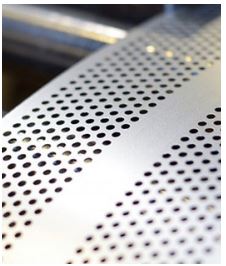 Perforation of material is accomplished by using mechanical means to penetrate, or “punch”, through material surface, leaving behind a hole of particular size and shape. In practice, perforated material typically consists of flat sheets that are modified by creating recurring patterns of punched shapes.
Perforation of material is accomplished by using mechanical means to penetrate, or “punch”, through material surface, leaving behind a hole of particular size and shape. In practice, perforated material typically consists of flat sheets that are modified by creating recurring patterns of punched shapes.
Implementation of perforated products into any project requires knowledge of the cost implications associated with specific metal configurations. It is important to understand the various characteristics of a sheet and the options available when specifying the product to be produced.
Before ordering custom perforated sheets, the buyer must typically specify these three traits:
1. Material Type and Thickness
There are many types of materials suitable for perforating, with what is most applicable for the specific projects dependent upon the material cost and properties. Commonly used materials for perforated metal are:
- Hot-rolled and cold-rolled carbon steel
- Galvanized Steel, typically pre-galvanized (galvanized prior to punching)
- Stainless steel (Type 304 and 316, both standard and low carbon varieties)
- Aluminum
- Brass
- Copper
Material thickness is also important to consider, especially since the cost of fabricated pieces is typically derived from the “per pound” price of the material, and perforated pieces are no exception. The thinner the perforated sheets, the less material used to create the finished piece, and therefore the lower the price per piece.
In addition to simply saving on material cost, it is easier for shops to punch and work thin(ner) sheets than it is to machine thicker pieces, which creates an associated savings in production costs as well. It is important to remember, however, that decreasing the cross-section of the sheets by choosing a lesser thickness will create a decrease in the structural capacity of the sheet.
Utilization of higher-strength pieces can, in some cases, result in an overall reduction in the number of pieces that are required. The designer must balance material thickness versus structural requirements to ultimately decide on the best way to achieve a cost-efficient project.
2. Hole Shape and Size
Perforated product producers are able to create a wide array of hole shapes and patterns in material sheets through the use of standard and custom punches, computerized punching pattern programs and special fabrication techniques.
- The types of hole shapes available in perforated products is limited only by the technological ability to machine the cutting dies into a specific configuration that can not only create the shape, but withstand the stresses of the punching process. A round hole is the easiest and most economical shape to incorporate into a perforated sheet, as the relative simplicity of machining a round piece results in low manufacturing costs.
- Hole size is determined by drawing a circle around the hole shape with a radius that extends from the center of the shape to its extreme outside edge. Typically the hole size is greater than or equal to the thickness of the material being punched, in most cases much greater. For high-strength material such as stainless steel, the hole size must generally be at least 2 to 3 times the thickness of the metal sheet in order to provide a clean cut, easier manufacturing and reasonable cost.
3. Margins
The end margin width on perforated sheets is normally zero, which means that there is no distance between the perforated patterns and the end of the sheet. This is known as an “unfinished pattern” and occurs when the punching continues to the ends of the sheet and the holes do not complete their last cut cleanly inside the sheet borders.
Stock sheets are most commonly available in an unfinished pattern configuration. It is also the least expensive way to fabricate a piece from scratch. If desired, a minimum margin width can be created on the ends, but require adjustments to the perforation process, resulting in more expensive sheets.
Learn More about Criteria Involved in Manufacturing Perforated Sheets
Knowing the exact specifications of your perforated product can help accelerate the project’s completion — and lets you know what to expect in terms of cost and timeline. To learn more about the factors that go into selecting your product, download our new eBook, Proper Selection for Perforated Products.









Comments are closed